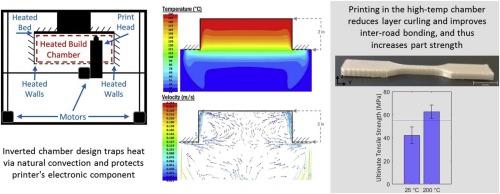Additive Manufacturing ( IF 10.3 ) Pub Date : 2020-02-13 , DOI: 10.1016/j.addma.2020.101111
Callie Zawaski , Christopher Williams

|
A heated build environment in Fused Filament Fabrication (FFF) additive manufacturing (AM) is used to promote layer bonding in printed parts and reduce the difference in temperature between the extrusion and environment decreasing the shrinkage, residual stresses, and part deformation. A build environment capable of maintaining a high-temperature (>200 °C) is often required to enable high-quality FFF printing of high-glass-transition, high-performance polymers such as nylon, PPSF, and ULTEM. Industrial-scale AM systems are capable of printing such polymers, as they offer a controlled, high-temperature printing environment; however, the machine cost often exceeds >$100,000. High-temperature printers are now available and at lower costs; however, the cost is still expensive (∼$30,000). Many of these printers use bed heating rather than controlled environment heating, which can lead to inhomogeneous heat transfer and inconsistent properties. The key barrier to offering high-temperature environments for desktop-scale FFF systems in a cost-effective manner is that the electrical components must be compatible with, protected from, or removed from environments exceeding 100 °C.
To enable desktop-scale FFF printing of high-performance polymers at a low cost and high quality, the authors present a novel inverted FFF system design that provides a build environment of up to 400 °C. The inverted configuration effectively isolates the system electronics from the heated build environment, which allows for the use of inexpensive components. In this paper, the authors verify the inverted design concept analytically via a computational fluid dynamics model. The concept is then experimentally validated via a comparison of the strength of PPSF components printed on the inverted desktop-scale FFF system.
中文翻译:

低成本,高温倒置构建环境的设计,可实现桌面规模的高性能聚合物增材制造
熔融长丝制造(FFF)增材制造(AM)中的加热成型环境用于促进印刷零件中的层粘合,并减少挤出和环境之间的温度差,从而减少收缩率,残余应力和零件变形。通常需要能够维持高温(> 200°C)的构建环境,以实现高玻璃化转变,高性能聚合物(例如尼龙,PPSF和ULTEM)的高质量FFF打印。工业规模的增材制造系统能够印刷此类聚合物,因为它们提供了受控的高温印刷环境;但是,机器成本通常超过100,000美元。现在可以以较低的成本获得高温打印机。但是,成本仍然很高(约30,000美元)。这些打印机中有许多使用床加热而不是受控环境加热,这可能导致传热不均匀和性能不一致。以经济高效的方式为台式机规模FFF系统提供高温环境的主要障碍是,电气组件必须与超过100°C的环境兼容,受到保护或从中移出。
为了以低成本和高质量实现桌面级FFF高性能聚合物的打印,作者提出了一种新颖的倒FFF系统设计,可提供高达400°C的构建环境。倒置配置有效地将系统电子设备与加热的构建环境隔离开,从而允许使用便宜的组件。在本文中,作者通过计算流体动力学模型分析性地验证了倒置设计概念。然后,通过比较倒置台式FFF系统上印刷的PPSF组件的强度,对该概念进行了实验验证。































 京公网安备 11010802027423号
京公网安备 11010802027423号